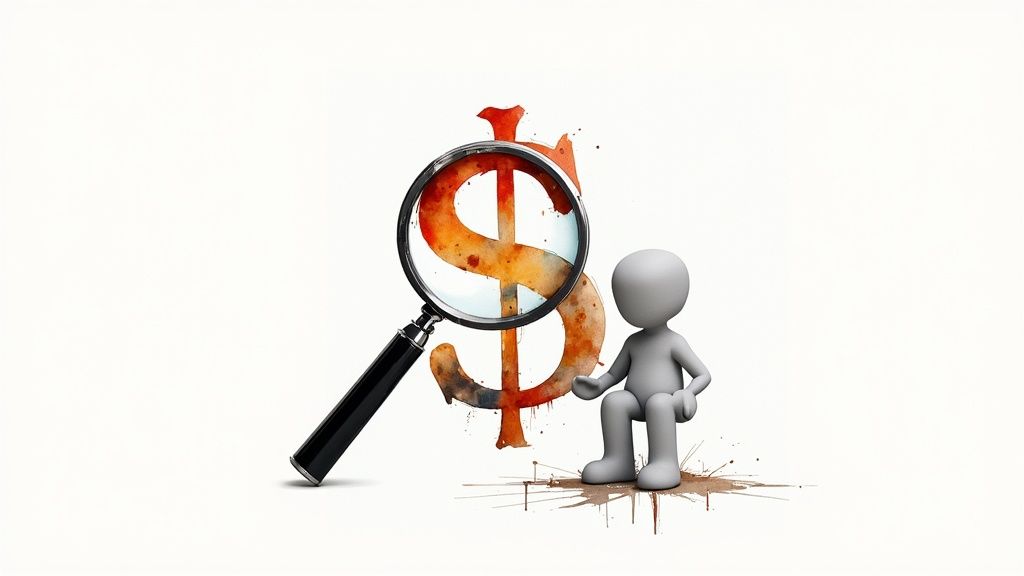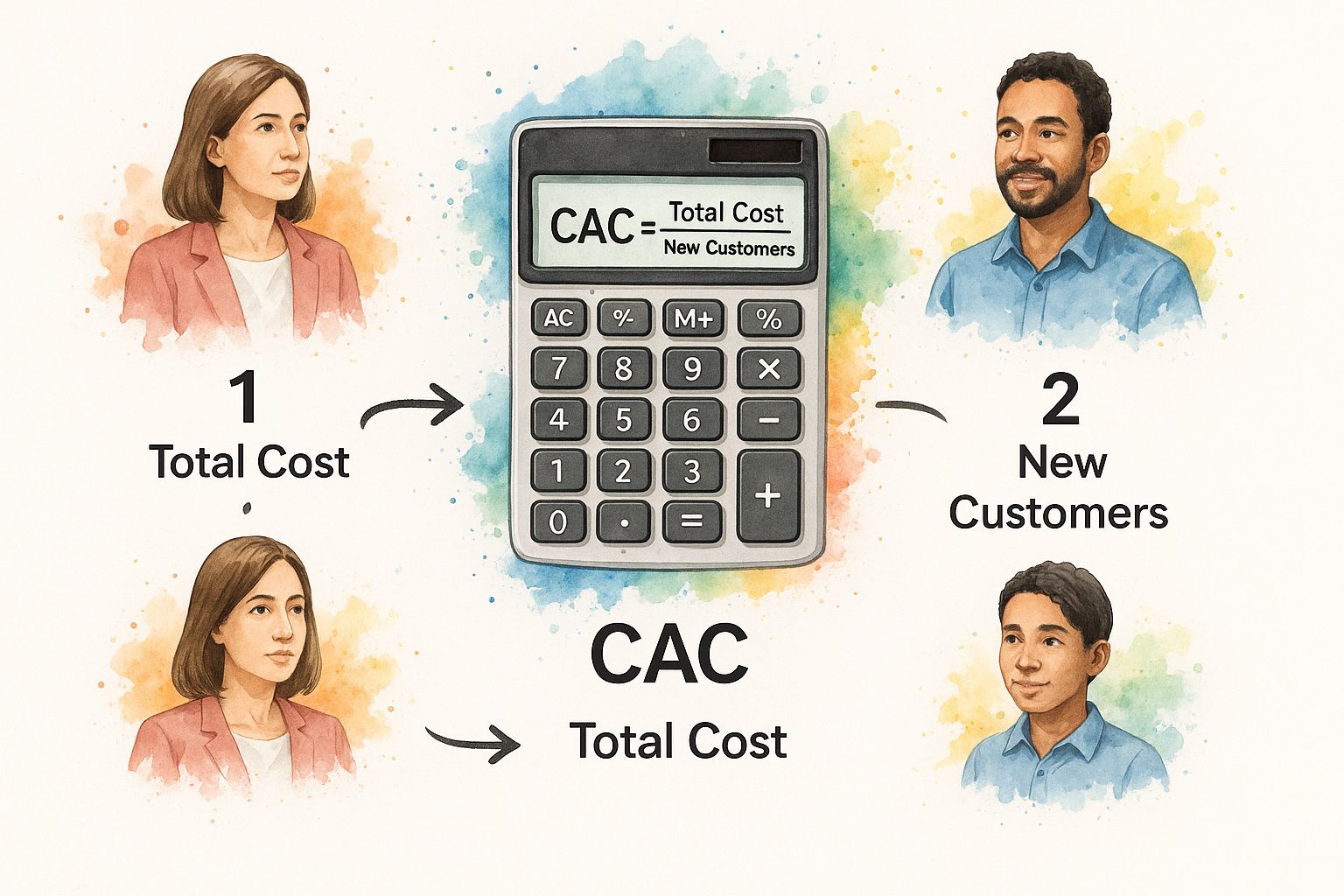Do you know exactly how much it costs to win a new customer? A customer acquisition cost calculator—often a simple spreadsheet—is a crucial tool that reveals this number. By totaling your marketing and sales expenses over a set period and dividing by the number of new customers you gained, you get your Customer Acquisition Cost (CAC). This isn't just an accounting metric; it’s one of the most vital indicators of your business's profitability and campaign effectiveness. Mastering this calculation is the first step toward building a sustainable growth strategy.
Why a Customer Acquisition Cost Calculator Is Essential for Growth

Understanding your Customer Acquisition Cost (CAC) is far more than an accounting exercise; it's the strategic foundation of sustainable growth. Without this number, you're essentially flying blind, investing in marketing channels without knowing which ones deliver a positive return. A clear CAC calculation empowers you to make confident, data-driven financial decisions.
It's the one metric that allows you to shift from guessing to knowing. Your marketing budget transforms from a mere expense line into a powerful engine for predictable growth.
Pinpoint Your Most Profitable Channels
Not all leads are created equal, and neither are the channels that generate them. While a blended CAC provides a high-level overview, the real insights emerge when you dig deeper and calculate CAC for each specific channel—whether that’s Google Ads, Meta ads, or local SEO efforts.
I've seen this play out time and again. For instance, a local realtor in Boca Raton might discover their Google Ads campaigns acquire new clients at a CAC of $350, while their organic blog content attracts clients for just $50. That’s a game-changing insight. It tells them precisely where to double down and where to optimize, enabling them to allocate their budget for the best possible ROI.
A healthy business requires a clear view of its financial engine. Tracking CAC isn't just about cutting costs—it's about reallocating resources to the channels that build long-term, profitable customer relationships.
Forecast Growth and Set Realistic Budgets
How much can you truly afford to spend to get a new customer? The answer lies in the relationship between your CAC and your Customer Lifetime Value (LTV). LTV represents the total revenue you can reasonably expect from a single customer throughout your business relationship.
A "good" CAC is entirely dependent on its corresponding LTV. Consider these two scenarios:
- A Small E-commerce Brand: They sell products with an average order value of $75 and an LTV of $150. A CAC of $100 would be a disaster, leaving no room for profit. Their target CAC should be much lower, perhaps in the $25-$40 range.
- A Real Estate Brokerage: A single new client could generate $10,000 in commission (their LTV). In this case, a CAC of $500 or even $1,000 is perfectly healthy and highly profitable.
When you understand this dynamic, you can set intelligent budgets, forecast future revenue with greater accuracy, and scale your business without sacrificing profitability. A customer acquisition cost calculator isn't just a spreadsheet; it's an essential tool for steering your entire marketing strategy. To see how we help businesses generate the right kind of leads, take a look at our fully managed ad solutions.
Assembling the Data for an Accurate CAC Calculation
Any customer acquisition cost calculator is only as good as the numbers you feed it. To get an honest look at your profitability, you must dig deeper than obvious costs like your monthly ad spend. A truly useful calculation demands a full accounting of every dollar that went into landing a new customer.
This means you need to be a bit of a detective, tracking down all related costs within a specific timeframe—typically monthly or quarterly. If you miss even one expense category, you can seriously skew your results. You might end up thinking a marketing channel is a goldmine when it's actually a money pit. It's the classic "garbage in, garbage out" problem, and the only way to avoid it is to be thorough from the start.
Direct vs. Indirect Costs
First, sort your expenses into two main buckets: direct costs and indirect costs.
-
Direct Costs: These are straightforward expenses you can attribute to a specific campaign. This includes your monthly spend on Google Ads, your budget for Facebook lead generation campaigns, or commissions paid to affiliate partners.
-
Indirect Costs: These are the sneaky expenses that are often forgotten. They aren't tied to a single campaign, but your acquisition efforts would collapse without them. Forgetting these will make your CAC look artificially low—a dangerous game to play.
Think of it like building a house. The direct costs are the lumber and nails. The indirect costs are the architect’s plans and the electricity for the power tools. You simply can't build the house without them.
Key Takeaway: A truly accurate CAC must include every cost that supports the customer's journey to conversion. The most common mistake businesses make is overlooking indirect expenses like salaries and software fees, which leads to a dangerously underestimated acquisition cost.
Building Your Cost Checklist
To ensure nothing slips through the cracks, I always recommend creating a detailed checklist. This simple practice transforms your customer acquisition cost calculator from a vague guess into a powerful diagnostic tool. Your list should be a healthy mix of both direct and indirect expenses.
Here are the absolute essentials you need to track:
- Total Ad Spend: This is the big one. Sum up every dollar you spent across all paid platforms—Google, Meta (Facebook and Instagram), LinkedIn, and any other ad networks.
- Marketing & Sales Salaries: You must account for your team's time. If your marketing manager spends 50% of their week on new lead generation, then include 50% of their salary for that period in your CAC calculation.
- Content Creation Fees: Did you pay a freelancer for blog posts? Hire a videographer for an ad? Commission a designer for social media graphics? All these creative costs contribute to acquiring new customers.
- Software & Tool Subscriptions: Don't forget the tech stack! Add up the monthly fees for your CRM (like AdfuelCRM), email marketing platform, analytics tools, and all the other software that keeps your sales and marketing engine running.
Once you've tallied these numbers, the real analysis begins. You can slice and dice the data, analyzing CAC by channel (is paid search more efficient than organic SEO?) or even by individual campaign. A local home services company might run the numbers and discover their highly-targeted Facebook ads have a much lower CAC than their broader Google Ads campaign. That's a huge insight, revealing a clear opportunity to shift their budget for better results.
This granular approach is how you graduate from just calculating CAC to actively optimizing it. If you need a hand spotting these opportunities in your own data, our ad management services are designed to do exactly that.
Building Your Customer Acquisition Cost Calculator
Now that you have a detailed list of all your acquisition-related expenses, it's time to put that data to work. Building a proper customer acquisition cost calculator doesn't require fancy software. A well-organized spreadsheet is all you need to gain powerful insights into your marketing performance.
The goal is to create a living document—something you can update monthly or quarterly to monitor trends. This is how you move from simply knowing your numbers to making genuinely smarter decisions about where your budget goes.
We're going to walk through setting up a simple but incredibly effective calculator that will organize your costs, crunch the numbers, and produce actionable figures.
First, let's ground ourselves in the basic math. It’s beautifully simple.

Ultimately, it's a straightforward division problem: total spend divided by new customers. Getting this right is the first step toward true optimization.
Structuring Your Calculator Spreadsheet
To get started, open a new spreadsheet in Google Sheets or Microsoft Excel. Your rows will be for every cost we identified, and your columns will represent different time periods (e.g., January, February, March) or specific marketing channels.
This structure is crucial because it gives you two equally important ways to look at your acquisition costs:
- Blended CAC: This is your 30,000-foot view. You add up all costs across every channel for a given month and divide by the total number of new customers. It’s a fantastic health check for your entire marketing machine.
- Channel-Specific CAC: This is where the diagnostic magic happens. By setting up separate columns or sections for "Google Ads," "Facebook Ads," "Organic SEO," and so on, you can isolate the performance of each one. This is how you answer the most important question: "Where is my money really working?"
Let’s imagine a real estate brokerage looks at their numbers for May and finds their blended CAC is $600. On the surface, that might seem okay. But when they dig into the channel-specific breakdown, they see their Google Ads CAC is a healthy $450, while their Facebook Ads CAC is a staggering $950. That insight immediately tells them they need to either fix what's broken in their Facebook campaigns or shift that budget to Google where it's performing better.
A blended CAC tells you if you have a problem. A channel-specific CAC tells you where the problem is. You need both for a complete picture of your marketing performance.
To ensure you're tracking everything, it helps to lay out your cost categories clearly.
Sample CAC Calculator Input Structure
This table outlines the essential cost categories and metrics to include in your customer acquisition cost calculator for an accurate and comprehensive analysis.
| Cost Category | Example Expenses | Why It's Important |
|---|---|---|
| Ad Spend | Google Ads, Facebook Ads, LinkedIn Ads, TikTok Ads | The most direct cost. Isolating by platform shows which channels are most cost-effective. |
| Salaries & Wages | Marketing team salaries, contractor fees | People are your biggest investment. This attributes team costs to acquisition efforts. |
| Software & Tools | CRM subscription, SEO tools, analytics software | The tech stack that powers your marketing isn't free. This ensures it's accounted for. |
| Content Creation | Freelance writers, video production, graphic design | High-quality content drives organic and paid efforts, and its cost needs to be tracked. |
| Overhead & Other | A portion of office rent, utilities, commissions | Captures the miscellaneous costs that support the marketing team and its activities. |
Having a structured layout like this prevents you from overlooking hidden costs that can skew your CAC.
Implementing the Formulas
Once your spreadsheet is set up with your costs, the math is easy. You just need a couple of key formulas at the bottom of each column.
- Total Costs: Use the
SUMformula to add up all expenses in that column. In Excel or Google Sheets, it’s as simple as=SUM(B2:B10)if your costs for the month are in cells B2 through B10. - CAC Calculation: Below your total cost, add a row for "New Customers" and manually enter the number you acquired for that period or channel. The final formula is simple division:
=B11/B12, where B11 is your total cost cell and B12 is your new customers cell.
With this in place, you’ve created an automated dashboard. Every month, simply plug in your latest expense figures and customer counts, and the calculator does the rest. This habit of consistent tracking elevates a simple calculation into a powerful strategic asset. If you want to see how this level of reporting is professionally integrated, check out how we structure our ad management services.
What Your CAC Numbers Are Actually Telling You

Calculating your Customer Acquisition Cost is a fantastic first step, but the number itself is just a starting point. The real value comes from understanding what it means for your business's health and future direction. Think of your CAC like a single vital sign; it’s useful, but you only get the full picture when you put it into context.
A CAC figure isn't "good" or "bad" in a vacuum. Its value is completely relative to your industry, your business model, and—most importantly—the revenue each new customer brings in over their lifetime. This is where you graduate from simply acquiring customers to acquiring profitable ones.
The LTV to CAC Ratio: The Gold Standard
To truly understand what your CAC means, you must measure it against your Customer Lifetime Value (LTV). LTV is the total revenue you can reasonably expect from a single customer. The relationship between these two metrics separates a sustainable business from one that's just burning cash.
The most important benchmark here is the LTV to CAC ratio.
As a rule of thumb, a healthy business should aim for a 3:1 LTV to CAC ratio. This is the sweet spot. It means for every dollar you invest in acquiring a customer, you get three dollars back in lifetime revenue. This signals both solid profitability and a healthy investment in growth.
If your ratio dips below 3:1 (e.g., 1:1 or 2:1), that’s a warning sign. You're likely spending too much to bring customers in the door, leaving little to no profit. Conversely, a very high ratio (like 5:1 or more) isn't always a cause for celebration. It can be a red flag that you're underinvesting in marketing and leaving potential growth on the table.
Interpreting High and Low CAC
Once you know your ratio, you can use your CAC as a diagnostic tool. Your customer acquisition cost calculator becomes your best friend in pinpointing specific issues.
- A High CAC is often a symptom of inefficiency in your funnel. It could mean your ad targeting is too broad, your landing pages are failing to convert, or you’re relying on one very expensive channel. For a local plumber, a high CAC might reveal they're burning cash on ads shown to people three towns over.
- A Low CAC can be a great sign of hyper-efficient marketing. But if it seems too low, it might mean you aren't spending enough to scale. You may be successfully grabbing the low-hanging fruit but failing to invest in channels that will take your business to the next level.
Remember, context is everything. CAC varies wildly by industry due to differences in sales cycles and contract values. For example, recent data suggests a Fintech company might see a CAC as high as $1,450, while an eCommerce SaaS business could hover around $274. Legal and manufacturing services often fall in between. Knowing these benchmarks helps you gauge if your costs are in the right ballpark. You can dive deeper into these industry-specific insights to see how you stack up. You can find more information on ecommerce CAC trends on LoyaltyLion and read more about global acquisition statistics for wider context.
Proven Strategies to Lower Your Customer Acquisition Cost
So, you've calculated your Customer Acquisition Cost. If the number is higher than you'd like, don't panic. A high CAC isn't a failure—it’s a data point. It’s your cue to refine your strategy and find efficiencies that lead to profitable growth.
The goal is to lower your costs without sacrificing lead volume. Luckily, there are several battle-tested tactics you can implement right away. These are practical steps focused on boosting conversion rates, sharpening your targeting, and getting more value from every marketing dollar.
Improve Conversion Rates with A/B Testing
One of the most direct ways to slash your CAC is by improving your conversion rate. You’re already spending the money to get people to your website; the next step is to convert more of those visitors. This is where A/B testing becomes invaluable.
Start by experimenting with critical elements of your campaigns:
- Ad Copy: Test different headlines, calls-to-action (CTAs), and value propositions. Does "Get a Free Quote" outperform "Learn More"? A small wording tweak can create a massive lift in click-through rates.
- Landing Page Design: Test the layout, form fields, hero image, and trust signals like customer testimonials. I’ve seen a local service business boost their form submissions by 15% just by adding authentic photos of their team to a landing page, which immediately lowered their CAC.
The key is to continuously test and learn, making data-driven improvements that turn more visitors into customers.
Refine Your Audience Targeting
Showing your ads to the wrong people is one of the fastest ways to inflate your CAC. The more dialed-in your targeting, the more efficient every ad dollar becomes. Dive into your analytics to understand who your best customers really are—their demographics, interests, and online behaviors.
For instance, a realtor specializing in luxury homes shouldn't waste ad spend on a broad audience. They need to be laser-focused on higher-income zip codes and users who show interest in golf, boating, or financial publications. This act of exclusion stops you from paying for clicks from people who were never going to convert anyway, directly lowering your cost per qualified lead.
Don’t just acquire customers—acquire the right customers. Focusing your marketing budget on high-value segments is the most direct path to a healthier LTV-to-CAC ratio and sustainable growth.
Bringing down your CAC is an ongoing cycle of testing, learning, and refining. When you pair a solid customer acquisition cost calculator with these strategic optimizations, you ensure every marketing dollar is working as hard as possible to grow your business profitably.
Still Have Questions About CAC? Let's Clear Them Up.
Even with the best tools, like a solid customer acquisition cost calculator, some questions always seem to pop up. That's completely normal. Let's walk through some of the most common ones I hear from marketers and business owners trying to get a handle on their spend.
What Is a Good LTV to CAC Ratio?
This is the big one. Everyone wants to know the magic number.
In a perfect world, you're aiming for a 3:1 LTV-to-CAC ratio. What does that mean in plain English? For every dollar you put into acquiring a new customer, you should be getting at least three dollars back over their lifetime with your business.
If your ratio is dipping below that, it’s a red flag that you might be overspending on acquisition. On the flip side, a really high ratio, say 5:1 or more, isn't always a cause for celebration. It could actually mean you're being too conservative with your budget and missing out on serious growth opportunities.
How Often Should I Calculate My CAC?
There’s no single right answer here, but I have a pretty solid rule of thumb.
For most businesses, running the numbers monthly hits the sweet spot. It gives you timely enough data to make smart adjustments without getting bogged down in analysis paralysis. From there, I always recommend a quarterly and annual review to zoom out and spot the larger trends you might miss in the day-to-day.
The exception? If you're in the middle of a short, intense campaign with a big budget, you'll want to be on top of it. Calculating CAC weekly during those high-stakes periods can help you pivot quickly if something isn’t working.
What Are the Biggest CAC Calculation Mistakes?
The most common mistake I see, hands down, is under-reporting costs. It's easy to just count your ad spend, but what about the tools you use to run those ads? Or a portion of your marketing team's salaries? Forgetting to include all the associated costs will give you a dangerously optimistic CAC.
A few other classic blunders include:
- Not breaking it down: Lumping all your acquisition spending into one bucket is a recipe for disaster. You need to separate CAC by channel to see which ones are your true workhorses.
- Ignoring the big picture: Calculating CAC in a vacuum is pointless. It only becomes a powerful metric when you compare it to your Customer Lifetime Value (LTV).
- Forgetting about geography: Your costs can vary wildly depending on where you're targeting. For instance, recent data showed North America's average cost-per-install was a hefty $5.28, while in the Asia-Pacific region, it was just $0.93. That's a huge difference and highlights why you can't apply a one-size-fits-all strategy.
Need help attracting quality leads at the right price? DigitalAdvertisingDirect.com can help you build and manage a hyper-targeted ad strategy. Get a free strategy session today.


